|
Body
Fat versus Body Weight |
| A
recent survey of American adults revealed that 71% of women
and 62% of men were trying to lose weight. The problem
is that most people think their weight, when in fact, fat
content is better indication of health. During a
well-rounded diet and exercise regimen, weight may fluctuate
while body fat will decline in a slow, steady rate.
Monitoring changes in both body fat and weight gives a more
dependable picture of fitness and is more encouraging because
it is a true indication of positive healthy change, compared
to monitoring only weight or appearance.
Another problem
is that when we recognize we have a problem, most of us aren't
sure what exactly we can do to reduce and then control our
weight. Occasional weighing on a bathroom scale or
looking in the mirror may not indicate a "fat"
problem. A person may have an acceptable figure, but if
their body contains too much or too little body fat, their
health could be at risk. By comparison, someone who
works out every day may weigh-in at the same weight, but their
body is composed of dense, lean muscle and less fat.
Neither appearance nor weight alone can tell you your
fat-to-muscle content.
Excess body fat can contribute
to medical conditions such as hypertension, heart disease,
high cholesterol, diabetes, digestive diseases and even some
forms of cancer. More then half of the American
adult population is overweight or obese (too much body fat)
and approximately 300,000 Americans die of health problems
related to obesity each year-- second only to cigarettes as a
leading preventable lifestyle-related cause of death.
Contrary to some common misconceptions, you can't turn your
fat into muscle... but, you can build muscle and lose
fat. A
healthy, permanent course of action is to lose (and keep off)
excess body fat by leading a healthy lifestyle. This can
be attained by modifying eating patterns and committing to a
regular, but reasonable, exercise program.
3,500 calories = 1 lb of body fat.
Most moderate cardio exercises will
burn 200-300 calories per 30 minutes while you are
exercising. Resistance training burns calories several
hours after the training session. A combination of
resistance training, aerobic exercise, and flexibility is the
most beneficial training balance that will contribute to
accomplishing most peoples fitness goals. For safety
reasons, weight loss goals
should average no more than 1-2 lbs per week by creating a calorie
deficit through a combination of diet and exercise (500-1000
calories per day). For long term
goals of maintaining your success once it is achieved, it is
important to maintain exercise along with a sensible
diet. These lifestyle changes will go a long way to the
success of your efforts.
|
|
Training Heart Rate |
|
An important
component of exercise for fat loss and health is aerobic (aka.
cardiovascular or cardio respiratory) exercise. This
type of training is called "aerobic" because you use
oxygen to burn fuel. Your exercise routine should
include aerobic training (ie. biking, walking, running, etc..)
3-4 days per week for optimum results. Gauge how hard to
push yourself by taking a percentage of your maximum heart
rate. To calculate this, subtract your age from 220.
Maximum Heart Rate: 220 -
Age
To derive any benefits from aerobic exercise, you
need to exercise in an elevated training zone which equates to
a percentage of your maximum heart rate.
Training Zones
Healthy Heart Zone (Warm up) --- 50 - 60% of
maximum heart rate: The easiest zone and probably the best
zone for people just starting a fitness program. It can also
be used as a warm up for more serious walkers. This zone has
been shown to help decrease body fat, blood pressure and
cholesterol. It also decreases the risk of degenerative
diseases and has a low risk of injury. 85% of calories burned
in this zone are fats!
Fitness Zone (Fat
Burning) --- 60 - 70% of maximum heart rate: This zone
provides the same benefits as the healthy heart zone, but is
more intense and burns more total calories. The percent of fat
calories is still 85%.
Aerobic Zone (Endurance
Training) --- 70 - 80% of maximum heart rate: The aerobic
zone will improve your cardiovascular and respiratory system
AND increase the size and strength of your heart. This is the
preferred zone if you are training for an endurance event.
More calories are burned with 50% from
fat.
Anaerobic Zone (Performance Training) ---
80 - 90% of maximum heart rate: Benefits of this zone include
an improved VO2 maximum (the highest amount of
oxygen one can consume during exercise) and thus an improved cardio respiratory
system, and a higher lactate tolerance
ability which means your endurance will improve and you'll be
able to fight fatigue better. This is a high intensity zone
burning more calories, 15 % from fat.
Red Line
(Maximum Effort) --- 90 - 100% of maximum heart rate:
Although this zone burns the highest number of calories, it is
very intense. Most people can only stay in this zone for short
periods. You should only train in this zone if you are in very
good shape and have been cleared by a physician to do
so.
Measuring Your Heart
Rate
Wearing
a heart rate monitor is an easy, accurate method of checking
your heart rate... but you don't have a monitor. Here is
another easy way.
The easiest place to feel your own
heart beat is the carotid artery. Place your index finger on
the side of your neck between the middle of your collar bone
and your jaw line. (You may also use the radial artery on the
under side of your wrist.) You can count the beats for a full
60 seconds or count for 6 seconds and add a zero at the end.
If you felt your heart beat 14 times in 6 seconds the number
would be 140 for a full 60 seconds. Counting for only six
seconds is a convenient method, of course it is more accurate
to count for the full 60 seconds. You can use several
varieties of this method (30 seconds x 2, 15 seconds x 4,
etc.). The longer you count the more accurate your reading.
Whatever you choose, be consistent in your
method.
| |
|
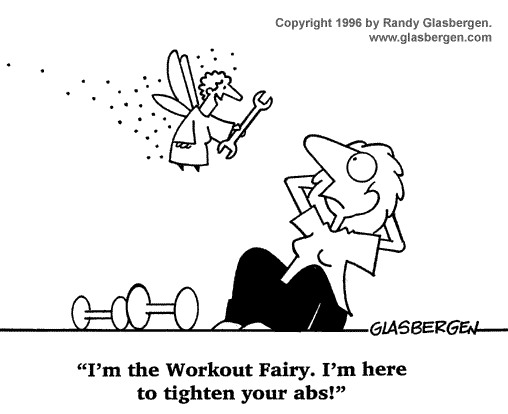
|
|
The
Complete Fitness Workout |
| A
complete fitness workout improves your shape, tone,
flexibility, endurance and strength. By using
these exercise components at least 3 times a week you
will attain a greater level of fitness and have a
stronger, leaner, and more limber
body. |
5–10
minutes |
WARM UP
A good warm up to 5-10 minutes of stretching
exercises or mild calisthenics helps prepare your
muscles, tendons, and ligaments for your blood flow,
enhances flexibility, while helping to reduce muscle
stiffness, soreness, and
injuries. |
20–30
minutes |
WEIGHT
TRAINING
Weight training is a fast and effective way to
improve your shape, tone, and strength. Workout at
least 2, preferably 3, times a week for 20-30 minutes
lifting 2-3 sets of 8-12 repetitions [1-2 of 15-20
repetitions for beginners.] Each workout should
develop your major muscle groups consisting of the
chest, shoulders, back, upper arm, stomach, buttocks,
and thigh. |
20–30
minutes |
AEROBIC
EXERCISE
The most important component of your fitness
program, especially if you are in your 30’s or older,
should be aerobic exercise. Your workout should
include at least 3 20-30 minute sessions of continuous,
rhythmic exercise at your target heart rate.
Depending upon your fitness level, and what you enjoy,
walking, jogging, climbing, cycling, rowing, swimming,
and aerobic dance are all excellent
activities. |
|
5–10
minutes |
COOL
DOWN
At the end of your workout session, ease your
heart rate and activity level to normal while you do
5-10 minutes of cool down stretching exercises, which
can be the same as your warm up stretches, or slow
walking. Cooling down helps prevent dizziness and
muscle soreness after your hard
workout. |
|
|
Elite
Bodyweight Exercise of the Month! |
|
Triceps Blast
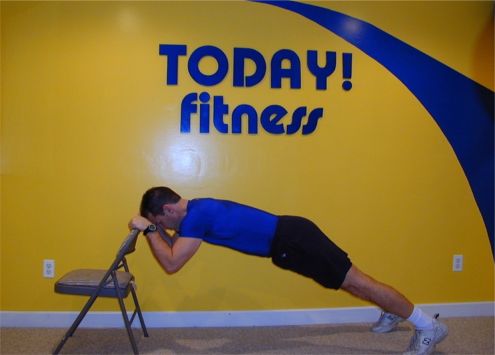
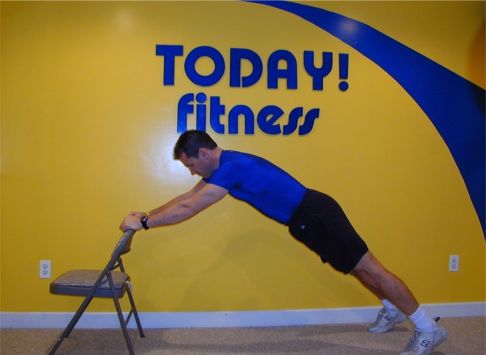
Target:
Primarily
Upper Arms, with core emphasis for stability (triceps,
deltoids & rectus abdominis)
Count: 2
count
Description: Starting
in the down position as shown, extend your arms while keeping
your feet in place. Starting position can be adjusted as
you become more accustomed to the exercise. The lower
the starting position (ie. chair seat rather than chair back)
the more difficult the exercise becomes.
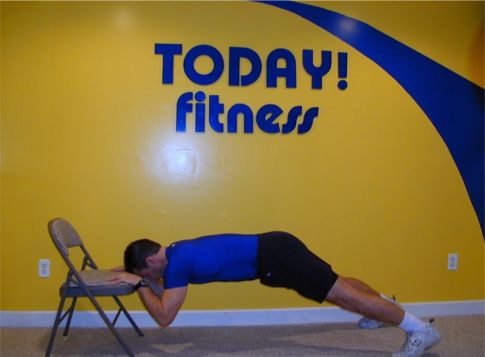
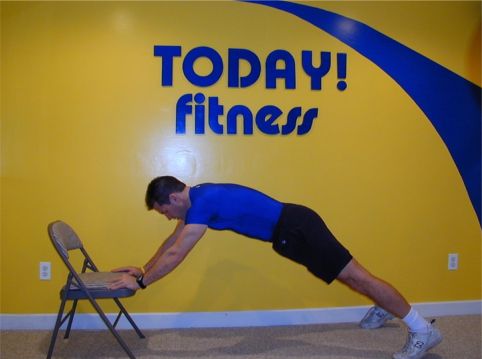
|
|
It's
Go Time! |
| So... you
just gave your eyes some exercise reading the second issue of
"The Day After Yesterday" eNewsletter. I'm sure that's
good for a couple of calories! Now what? Well if
you're already in a regular exercise routine then
congratulations and good luck working towards your next
goal! Remember: "you only fail when you stop
trying"! If you haven't started yet then WHAT ARE YOU
WAITING FOR? Unless you are sick, have a medical
condition or injury that will prevent you from exercising,
then you must be either procrastinating or just decided that
it is not that important to you. The ball is in your
court... you decide what to do with it!
I received a lot of positive
feedback about the last issue and will continue to aim for
making this a monthly publication. You can review prior
issues on my website at www.todayfitness.net/news.
Your input in regards to format, content, or anything relevant
is always welcome. Just shoot me an email with your
suggestions or comments and I will take them into
consideration.
If you would like to add someone to
this distribution list, please send an email to news@todayfitness.net
and include their name and email address. Likewise, if
you would like to be removed from this distribution list,
please state this in an email to the same address.
Thanx again for taking your time to
read another issue... did I mention that you can print this
out and read it while you are on the exercise bike or
treadmill?
Good Luck!
Pete
Mazzeo
pmazzeo@todayfitness.net
"The
only easy day was yesterday" | |
![]()
